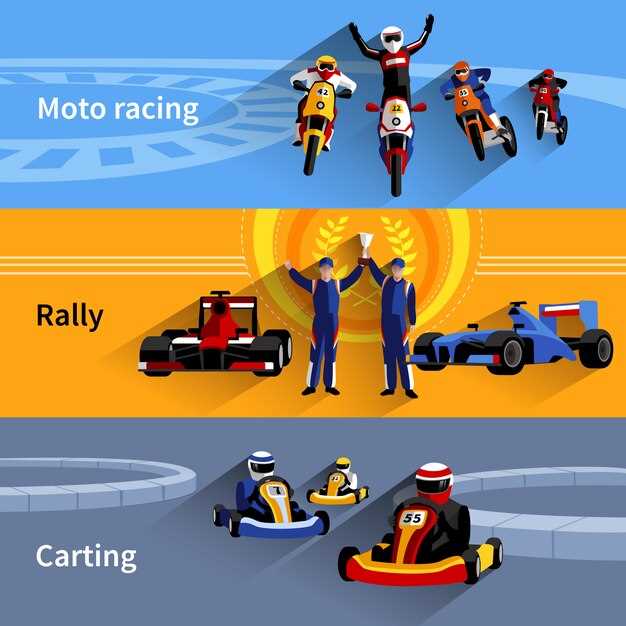
The concept of a dual-purpose vehicle, designed to excel both on the race track and the daily street, captivates automotive enthusiasts who crave performance without compromising practicality. Engineered to navigate the challenges of a competitive racing environment while retaining the comfort and usability necessary for everyday driving, this project requires a meticulous balance of power, handling, and style.
When constructing a vehicle that transitions seamlessly between racing and daily use, one must consider several critical factors. Suspension tuning must accommodate aggressive cornering on the track, while still providing a comfortable ride on city streets. Choosing the right set of tires becomes crucial; those that offer fierce grip during races must also maintain durability for daily commutes.
Additionally, the engine setup plays a pivotal role in defining the vehicle’s performance characteristics. A balance between horsepower and torque is essential to ensure a satisfying driving experience, whether tearing through a race circuit or navigating urban traffic. By integrating cutting-edge technologies and focusing on key enhancements, builders can create a machine that embodies the spirit of both racing and daily driving.
Selecting the Right Base Model for Performance and Comfort

Choosing the right base model for a dual-purpose race and daily driver vehicle is crucial for achieving the perfect balance between performance and comfort. A well-selected foundation can enhance your street driving experience while still enabling competitive performance on the race track.
1. Understand Your Requirements
Identify your primary usage: Will you be spending more time on the street or at the racetrack? This will influence your choice of make and model. A street-capable racer should provide comfortable seating and handling for daily use while boasting performance potential when pushed.
2. Look for Performance Upgrades
Base models that are already equipped with performance features can be advantageous. Consider vehicles with a strong aftermarket support, as they often offer upgrades like suspension, brakes, and engine enhancements. Popular choices tend to be models that have been successful in both street and race environments.
3. Comfort Isn’t Optional
Don’t sacrifice comfort for performance. A daily driver requires features such as a comfortable ride quality, sound insulation, and user-friendly technology. Look for interiors that provide ample space and premium features, ensuring an enjoyable experience during regular commutes.
4. Suspension and Handling
A performance-oriented suspension system is critical for a racer. Models that offer adjustable suspensions or sport-tuned setups allow for customizability based on either racing needs or daily driving comfort. Be sure to test drive to assess handling and comfort levels on city streets.
5. Engine Performance and Efficiency
Seek a base model with a balanced engine that provides power without sacrificing fuel efficiency. Turbocharged engines are popular due to their ability to deliver substantial power while remaining manageable in everyday situations. Ensure the vehicle accelerates seamlessly and provides a satisfying driving experience both in a racing context and on the street.
6. Safety Features
Incorporating safety features is vital for a daily driver. Look for models with advanced safety technologies like adaptive cruise control, lane-keeping assist, and robust crash-test ratings. A secure vehicle allows you to race confidently while offering peace of mind during everyday travels.
In conclusion, the ideal base model should cater to both the racer’s needs for performance on the track and the everyday driver’s requirement for comfort on the street. By carefully assessing these factors, you can build a versatile vehicle that excels in both environments.
Upgrading Suspension for Improved Handling on Track and Street
Upgrading the suspension is a critical step in transforming a standard vehicle into a dual-purpose machine that can excel both as a daily driver and a track-ready racer. The right suspension setup enhances handling, improves comfort, and increases overall performance under various driving conditions. Here’s how to achieve that balance.
- Selecting the Right Components:
- Coilovers: Adjustable coilovers allow for precise tuning of ride height and dampening settings, giving the driver the flexibility to switch between comfort for daily driving and firmness for racing.
- Sway Bars: Upgrading sway bars reduces body roll during cornering, which is especially beneficial on the track, while still maintaining comfort on the street.
- Strut Braces: These components enhance chassis stiffness, improving handling and response without sacrificing ride quality.
- Tuning for Dual Purposes:
- Ride Height: Lowering the ride height improves aerodynamics and lowers the center of gravity, enhancing cornering performance.
- Damping Settings: Adjustable damping allows drivers to dial in settings that can cater to both aggressive track days and smoother daily commutes.
- Understanding Geometry:
- Alignment: Proper wheel alignment is crucial for ensuring that the vehicle handles predictably on track while remaining comfortable on city streets.
- Camber Adjustment: Adjusting camber angles can optimize tire contact during hard cornering, boosting grip on the track while reducing uneven tire wear during daily use.
- Testing and Feedback:
- On-Track Testing: It’s important to test the suspension setup at the track to assess handling and make necessary adjustments.
- Daily Driving Feel: After track testing, evaluate the vehicle during daily driving to ensure it meets comfort and usability expectations.
By focusing on these aspects, enthusiasts can create a well-balanced suspension system for their dual-purpose vehicle, ensuring it performs as a competent racer on track days while remaining enjoyable for daily commuting.
Balancing Performance Mods: Power vs. Reliability

When building a dual-purpose vehicle that can perform as both a racer on the track and a reliable daily driver on the street, the balance between power and reliability is crucial. Enthusiasts often face the dilemma of choosing modifications that enhance performance without sacrificing the vehicle’s dependability.
Performance modifications, such as turbochargers, aftermarket exhaust systems, and high-performance tuning chips, can significantly increase horsepower and torque. However, these upgrades can also place additional stress on the vehicle’s components, leading to increased wear and potential failures. For instance, while a high-performance turbo can provide exhilarating acceleration, it may also necessitate stronger internals and better cooling systems to handle the extra heat and pressure.
Conversely, reliability is paramount for a daily driver. Owners must consider the long-term implications of their racing mods on everyday usability. Simple modifications, like upgrading the suspension for better handling, can enhance both performance on the racetrack and comfort on city streets without compromising reliability. It’s essential to focus on quality parts and professional installation to ensure modifications contribute positively to both performance and durability.
A balanced approach includes prioritizing upgrades that offer performance gains while maintaining the vehicle’s reliability. For example, investing in a quality engine management system can help optimize power delivery and fuel efficiency, making the vehicle more responsive without overloading critical components. Additionally, practical upgrades like reinforced brakes and tires provide the necessary traction and stopping power for racing, while still being suitable for street use.
Ultimately, the key to successfully balancing performance mods lies in thorough research and thoughtful planning. Enthusiasts must evaluate their driving habits, determine the primary use of their vehicles, and strategically choose modifications that enhance racing capabilities without undermining everyday reliability. Building a dual-purpose vehicle is a rewarding challenge that requires careful consideration of how each modification impacts power, reliability, and the overall driving experience.
Choosing Tires That Suit Both Racing and Daily Driving Needs
Finding the right tires for a vehicle used in both racing and daily driving can be challenging. The ideal tire must provide excellent performance on the track while still being suitable for regular street use. This requires careful consideration of several factors, including tread design, rubber compound, and tire size.
Tread design plays a crucial role in tire performance. For racing, tires often feature a slick surface to maximize grip on dry tracks, but such designs are not practical for daily driving due to a lack of water dispersion capabilities. All-season or performance tires with a balanced tread pattern are generally more appropriate as they provide adequate traction on the street and can handle occasional track days.
The rubber compound used in tires also affects their performance. Racing tires typically utilize softer compounds, allowing for superior grip and responsiveness. However, this softness means they wear out quickly and may not be suitable for day-to-day driving. Thus, a tire that combines a medium compound designed for longevity with improved grip will serve both purposes well, providing a good balance between daily durability and racing performance.
Size is another critical factor, as it influences handling characteristics. Many racers opt for wider tires for better stability and cornering. However, wider tires can increase rolling resistance and reduce fuel efficiency in daily driving. Choosing a tire size that offers a middle ground–slightly wider than standard tires but not excessively so–can enhance performance on both the street and the race track.
When finally selecting the tires, consider brands that specialize in dual-purpose options. Many manufacturers now offer performance tires explicitly designed for versatile use, ensuring that drivers do not have to sacrifice daily drivability for racing capabilities. Remember to check customer reviews and performance tests to find the best fit for your unique driving needs.
Integrating Safety Features for Track Days and Everyday Use
When designing a vehicle that operates both as a daily driver and a track-ready racer, safety features play a crucial role. Integrating safety elements ensures that the car provides protection during high-speed track days while remaining reliable for everyday street use.
First and foremost, installing a quality roll cage is essential. This structure enhances driver and passenger safety by reinforcing the car’s frame, providing additional support in case of a rollover incident on the track. For daily driving, a well-designed roll cage can be integrated in a way that does not overly compromise comfort or accessibility.
Next, racing harnesses should be considered. Unlike standard seatbelts, racing harnesses secure occupants more effectively during maneuvering. They can be a legal requirement on the track but can also enhance safety during everyday commutes, ensuring that drivers maintain optimal control under various driving conditions.
Another critical aspect is the selection of braking systems. A performance brake kit tailored for racing will provide better stopping power, crucial for high-performance driving on the track. Upgrading to high-quality pads and rotors ensures reliability during daily routes, giving peace of mind when driving in urban environments.
Moreover, modern vehicles benefit from advanced electronic stability controls. This technology offers support on winding roads and helps prevent loss of traction–vital during spirited drives at the racetrack as well as on the street. Ensuring compatibility with both driving contexts will enhance overall safety.
Lastly, investing in high-performance tires that strike a balance between grip and durability is important. Track-focused tires offer better performance but can wear down faster in everyday use. Alternatively, finding a versatile option that meets both needs allows the car to perform well in diverse driving scenarios without sacrificing safety.
By thoughtfully integrating these safety features, a dual-purpose vehicle can excel as a racer on the track while providing a secure and comfortable driving experience for daily street use.
Creating a Maintenance Schedule for Dual-Purpose Vehicles
When building a dual-purpose vehicle that serves both racing and daily driving needs, maintaining an effective and comprehensive maintenance schedule is essential. This schedule ensures that the vehicle remains in optimal condition for both street use and race conditions. Below is a detailed outline of the key components to consider when creating a maintenance schedule for a dual-purpose vehicle.
| Maintenance Task | Frequency | Comments |
|---|---|---|
| Oil Change | Every 5,000 miles or after each race | Using high-performance oil is crucial for race days. |
| Tire Inspection | Monthly | Check tread depth and pressure; switch between street and race tires as needed. |
| Brake Check | Every 2,500 miles or after each race | Inspect pads and discs; race conditions cause quicker wear. |
| Fluid Levels (Coolant, Transmission, Brake) | Bi-weekly | Regularly monitor to prevent overheating during races. |
| Battery Condition | Monthly | Ensure terminals are clean and battery is charged for both racing and daily tasks. |
| Suspension Inspection | Every 10,000 miles or after major race events | Check for wear and tear; important for handling both on the street and track. |
| Engine Performance Tune-Up | Every 15,000 miles or before major races | Enhance efficiency and power; includes spark plug and air filter replacement. |
| Exhaust System Check | Every 10,000 miles | Ensure there are no leaks that could affect performance. |
By adhering to this structured maintenance schedule, owners can enhance the reliability and performance of their dual-purpose vehicles. Regular checks and balances are crucial to avoid potential issues on race days while ensuring a comfortable and safe daily driving experience.




